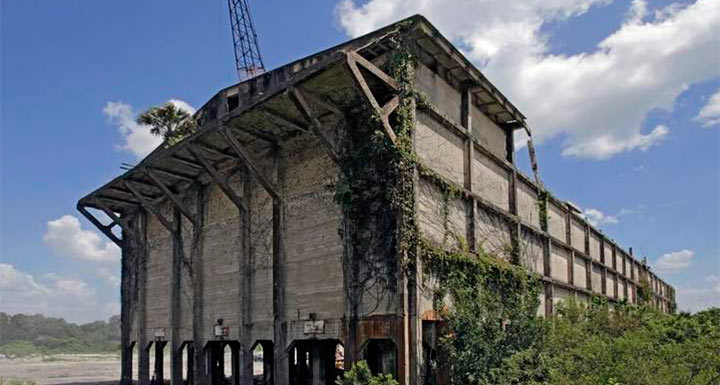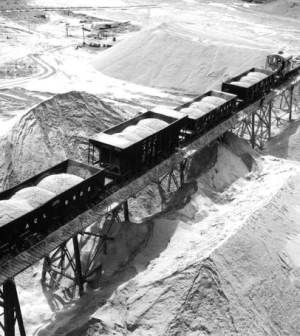
Phosphates past being reduced to rubble
Piece by piece, remnants of Florida’s phosphate mining roots are collapsing into rubble.
Last month, a wrecking ball began crushing a century-old Polk County building that used to store phosphate until the newly mined rock dried out. The massive structure of steel-reinforced concrete, built near Mulberry in 1909, was among the few vestiges of phosphate’s rise as a Polk County economic powerhouse.
Now, the old Prairie Pebble Phosphate Co. building is little more than 28,000 tons of concrete debris, and the sight of its crumbling walls tugged at Richard Fifer’s heart.
“I hate to see these old buildings come down,” said the Mulberry historian. “They represent an era we’re never going to get back. Sure, we still have some remnants of the 1950s and the ’60s, but there’s really nothing left from the early days in the 1910s and 1920s.”
 The 40,000-square-foot Prairie building, called a dry bin, had been shut down since 1964, when newer technology rendered it obsolete.
The 40,000-square-foot Prairie building, called a dry bin, had been shut down since 1964, when newer technology rendered it obsolete.
Scavengers had stripped away most of its steel, leaving it precariously unsafe, said John Simon, president of Tampa-based JVS Contracting, which bought the building and surrounding 17 acres in May.
“It was in dangerous condition,” he said. “All the steel was gone and probably sold for scrap. There were huge steel column supports that had been taken out, and nobody realized the danger that was putting people in.”
Discarded mattresses suggested vagrants had been camping inside, said Simon, who plans to establish a concrete-crushing business on the site at 1211 Prairie Mine Road.
“The only thing left in there was concrete and trash,” he said.
Lloyd Harris, a Bartow historian and longtime member of the Polk County Historical Commission, said preserving structures like these can be challenging.
“There’s not been a big push to preserve any of these old mines and pieces of them because it’s so expensive,” he said. “Those places are so huge and, in many cases, so remote.”
Another example sits a few miles south of the Prairie building in the ghost town of Brewster.
“The Brewster smokestack might very well be the last remnant of anything that’s pre-World War II, except what’s in memoirs and photographs,” Harris said.
The brick smokestack anchored the power plant at Brewster, a mining town about 10 miles south of Mulberry that disappeared in 1961.
Brewster was a company town, and Amalgamated Mining Co. and its successors owned everything in it. The town was created in 1911, and by the 1930s, Brewster boasted a post office, a grocery store, a railroad depot and a school through the 12th grade. It had about 1,800 company houses, many with indoor bathrooms, for employees and their families.
But all of that is gone now, all but the smokestack. Amalgamated’s successor, American Cyanamid Co., shut the town down in 1961, allowing employees to buy their wood-framed houses cheaply, if they’d move them. Many moved to nearby Fort Meade, Bartow and Mulberry, and a scattering of those houses still exist, Fifer said, but most have been remodeled and bear little resemblance to their original designs.
It wasn’t long after Brewster became a memory that Amalgamated brought in its drag-lines, gouging into the land where those houses and other buildings once stood. For whatever reason, the smokestack remained unscathed.
For years, pilots used the 226-foot-high smokestack as a landmark when they navigated across southern Polk County, which could be why it’s still there, said Callie Neslund, spokeswoman for Mosaic Co., Amalgamated’s successor. Only recently did a taller transmission tower replace it on aviation maps.
The aviation interest, combined with the nostalgia of the smokestack and the potential cost of demolition, all likely contributed to its survival, she said.
Neslund said Mosaic is reclaiming that area now and has no current plans to disturb the historic chimney.
“At some point in the future, it may make sense to have it torn down,” she said. “For now, we’re happy to let it stand as a tribute to the old mining town of Brewster.”
Steph Cecil of Lakeland appreciates that it’s there when she visits the area of State Road 37 and County Road 630, where her hometown used to be.
“That’s the only way we can tell where Brewster was,” said Cecil, 77, who was born within a stone’s throw of the town’s depot in 1936. “That was really one end of the town of Brewster, and the other side was to the west. I lived there, in a wood-frame house, until 1956, two years after I graduated from high school.
“This stack is all that’s left,” said Cecil, whose father was a chemist and director of the mine’s laboratory. “It’s really sad for those of us who grew up there. It was a great place to live, and now it’s gone. I like knowing that at least the smokestack is still there. At least we have that.”
Patricia Prine, who grew up next door to Cecil, said she’d be heartbroken if the stack was torn down.
“It means the world to me because Brewster means the world to me,” said Prine, 78, whose children were born there.
She said she frequently travels from her home in Fort Meade to the area where Brewster was and her father worked as a diesel mechanic, and she stops near the place where the depot once stood.
“It makes me sad,” she said. “I know progress has to go on, but small towns like Brewster are what helped build this country, and ours is gone. We have nothing else to mark where our town was except for that smokestack. It’s all that’s left.”


